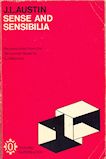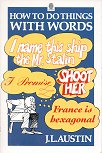As it says on the front cover, this book is “reconstructed from the Manuscript Notes by G. J. Warnock”. Versions of these notes span several years of giving the set of lectures, from 1947–1958. Warnock provides a preface describing the reconstruction approach. Being based on lectures, the book does have a nicely conversational style.
The conversation is about Austin’s response to certain philosophers (mostly Ayer and Price, but also, to some degree, Warnock himself, amusingly enough) and their approach to perception. I don’t know what the current state of the philosophy of perception is, but this book is worth reading just as an illustration of how Austin goes about eviscerating others’ arguments.
The sense one gets is that Austin is exasperated by his colleagues’ oversimplification and possibly deliberate obtuseness when investigating certain aspects of this, and other, philosophical problems. He doesn’t mince his words. (Is this style a feature of the words being spoken in a lecture, rather than written in a book or paper? I don’t know; but given this was reconstructed from Austin’s own written notes, I suspect not.)
I had to look up Gleichschaltung: a term used by the Nazis for “forcible coordination”; this appears to be a rather savage criticism to apply to a philosophical style!
In the first half Austin carefully picks apart the way “common mortals” use terms like “looks”, “looks like”, “looks as if”, “appears”, “appears like”, “appears as”, “appears as if”, “seems”, “seems like”, and so on. He teases apart subtle distinctions, to demonstrate that the philosophers who lump these all together under one restricted meaning are missing most of the richness of meaning, and hence being led astray in their subsequent philosophising.
Then in the second part, he picks apart use of the word “real”, here criticising Ayer in particular for using the word too fluidly, not recognising its multiple meanings, conflating them, and hence causing confusion.
This may sound a little strange: a book picking apart the meaning of a few words? But it is wonderfully readable, and gives an insight into deep and clear thought processes. And the exasperated style enlivens it considerably.
[I must confess that, although I had appreciated that the title is a pun, I had not appreciated quite how delicious a pun it is until, glancing at the cover, I misread the author!]

